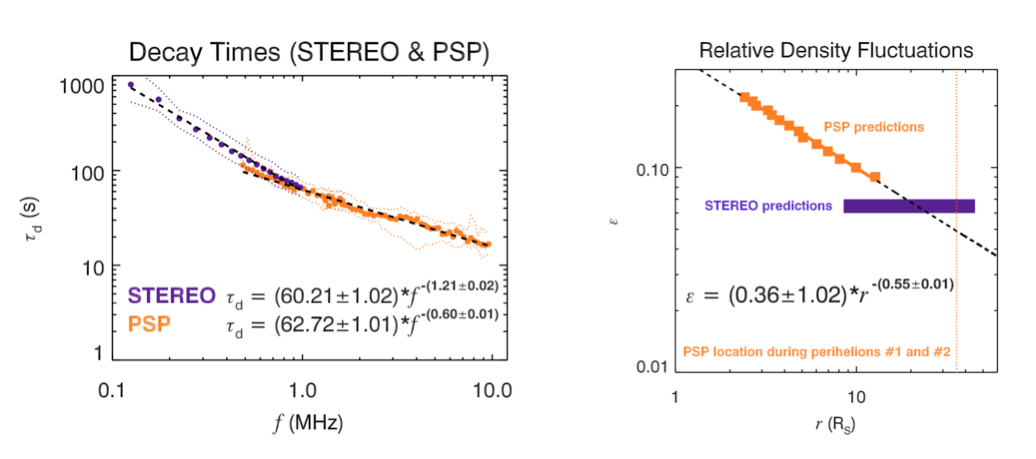Type III bursts belong among the strongest radio signals routinely observed by both space-borne and ground-based instrumentations. They are generated via the plasma emission mechanism, when beams of suprathermal electrons interact with the ambient plasma triggering radio emissions at the plasma frequency (the fundamental emission) or at its second harmonic (the harmonic emission). As the electron beams propagate outward from the Sun, radio emissions are generated at progressively lower frequencies corresponding to a decreasing ambient solar wind plasma density. Type III bursts can be simultaneously detected over a broad range of longitudes and their radio sources lie at considerably larger radial distances than predicted by electron density models. These obscure properties are often attributed to the scattering of radio waves by electron density inhomogeneities. The Parker Solar Probe (PSP) spacecraft, launched in August 2018, is a project of NASA to probe the outer corona of the Sun (http://parkersolarprobe.jhuapl.edu/). Its main science goal is to determine the structure and dynamics of the Sun’s coronal magnetic field, understand how the solar corona and solar wind are heated and accelerated, and determine which processes are responsible for solar energetic particles. Our contribution is dedicated to a statistical survey of type III burst decay times and in-situ density fluctuations measurements.

Figure 1 – Results of the statistical survey of 152 and 30 type III radio bursts for STEREO and PSP. (a) Median values of decay times. (b) Relative density fluctuations. Predicted relative density fluctuations by STEREO are shown in purple.
We have analyzed a large number of type III bursts observed by PSP during the perihelion #2 in order to statistically retrieve their exponential decay times as a function of frequency (Figure 1a). During this period, radial distances from the Sun ranged from 35.7 to 53.8 solar radii. Recently, Krupar et al. (2018) performed a similar analysis of 152 type III bursts between 125 kHz and 1 MHz observed by the STEREO spacecraft located at 1 au. The obtained spectral index is about twice smaller than for PSP. We note that a plasma frequency of 1 MHz—where the slope changes between STEREO and PSP—corresponds to a radial distance of 8 solar radii, where the solar wind speed typically exceeds the Alfvén speed, and the solar wind become super-Alfvénic. It is thus no surprise that type III burst properties change around frequency of 1 MHz as the background plasma changes significantly. We note that type III bursts exhibit also a maximum of power spectral density at 1 MHz.
We have implemented a Monte Carlo simulation technique to study a role of scattering to decay times. From the arrival times we calculated the decay times that we compare to those observed by PSP. Our results suggest that the exponential decay of the observed power spectral density can be explained by the scattering of radio signal by density inhomogeneities in the solar wind. Obtained relative electron density fluctuations are 0.09-0.22 at the effective turbulence scale length (Figure 1b).
Conclusions
Type III burst decay times between 1 and 10 MHz are statistically longer than expected based on previous observations at lower frequencies. This can be explained either by different ambient plasma parameters above the Alfvén point or because we preferably observe the harmonic component above 1 MHz. If the latter is true, variations in exponential decay times can be used to distinguish fundamental and harmonic components within one single type III burst. By comparing PSP observations and Monte Carlo simulations, we predicted relative density fluctuations at radial distances between 2.5 and 14 solar radii to range from 0.22 and 0.09.
Additional info
Based on the recent paper by Krupar et al. (2020), Density Fluctuations in the Solar Wind Based on Type III Radio Bursts Observed by Parker Solar Probe, Astrophysical Journal Supplement Series, 246, 57 (2020) doi: https://doi.org/10.3847/1538-4365/ab65bd in a special issue “Early Results from Parker Solar Probe: Ushering a New Frontier in Space Exploration” (https://iopscience.iop.org/issue/0067-0049/246/2).
References
Krupar, V., Maksimovic, M., Kontar, E. P., et al. 2018, ApJ, 857, 82
*Full list of authors: Vratislav Krupar, Adam Szabo, Milan Maksimovic, Oksana Kruparova, Eduard P. Kontar, Laura A. Balmaceda, Xavier Bonnin, Stuart D. Bale, Marc Pulupa, David M. Malaspina, John W. Bonnell, Peter R. Harvey, Keith Goetz, Thierry Dudok de Wit, Robert J. Macowall, Justin C. Kasper, Anthony W. Case, Kelly E. Korreck, Davin E. Larson, Roberto Livi, Michael L. Stevens, Phyllis L. Whittlesey, and Alexander M. Hegedus
